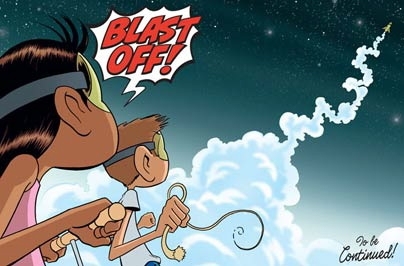Splurt! Urgghh! Ping! Thump! Boom boom bap!
It's not exactly cutting-edge technology, but those could be the sounds of future scientists and engineers in the making.
In a series of colorful, fun-filled comic-book pages, cartoon kids Celine and Tucker set up a home workshop and then proceed to build a whole series of toys and gadgets out of leftover items. They are the heroes of a just-released MIT-spawned book called "Howtoons" (HarperCollins, 2007), designed to inspire youngsters all over the world with a sense of can-do adventure, and to teach them a few principles of science and engineering--and a sense of the creative possibilities all around them--along the way of just having fun.
Howtoons, which also offers a variety of pictorial home-build projects at howtoons.com, is the brainchild of Joost Paul Bonsen, program director of MIT's new Legatum Center for Development and Entrepreneurship, and writer and engineer Saul Griffith, who earned his Ph.D. at MIT and earlier this year won a MacArthur Foundation "genius" award. "What we hope is that kids everywhere will not look at throwaway stuff the same way ever again," Bonsen says. Instead, they will realize than an old plastic bottle "can be a rocket or a submarine or any number of things."
The idea for Howtoons came about when Bonsen and Griffith were MIT graduate students (Bonsen at the Sloan School of Management and Griffith at the Media Lab). They helped to organize some workshop parties for local schoolchildren and invited MIT professors to come and bring their families. At these workshops, some of the construction projects that ended up in the book evolved spontaneously as people tinkered and experimented with a variety of simple materials. The impetus for developing the concept into a business plan came when they took a class in developmental entrepreneurship taught by Legatum Center founder and faculty director Alex "Sandy" Pentland.
The projects range from rockets and goggles to simple electric motors, a marshmallow-shooting blowgun, and a simple way of making homemade ice cream. The materials are mostly everyday items like plastic bags and bottles, rubber bands and paper clips.
Bonsen and Griffith enlisted the help of cartoonist Nick Dragotta, who has worked for comic-book powerhouses Marvel and DC, to put the projects into visual form. The idea is to make the instructions as visually self-explanatory as possible, so that kids anywhere can use them without having to read the words (although the book will also be translated into several languages). Eventually, new versions specifically designed for the materials, culture and climate of other countries will also be produced.
Tucker and Celine were designed to be "realistic kids, but drawn in a superhero style," Bonsen says. The idea was to have them "be able to do anything--fix things, make things," he says, and thus provide an example for young readers to adopt the same kind of creative, can-do approach to their surroundings.
"We want to inspire them," Bonsen says, "to think about the world around them not as it is, but as it could be."
A version of this article appeared in MIT Tech Talk on December 5, 2007 (download PDF).







